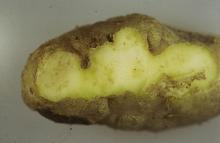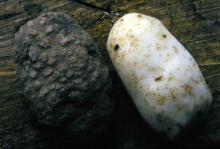By R. E. Ingham, P. B. Hamm, and C. M. Ocamb
Cause The northern (Meloidogyne hapla) and Columbia (M. chitwoodi) root-knot nematodes are among the most important problems in potato production. Very low soil populations can result in significant damage. Both nematodes blemish tubers and may render them unmarketable. M. chitwoodi is more important than M. hapla, causing more severe tuber damage. Both are sedentary endoparasites, and only the second-stage juveniles (the infective stage) and adult males (which may be rare) are present in soil. The disease spreads by infected tubers (seed or commercial), reused irrigation water and via soil. M. chitwoodi continues to develop above 41°F, but M. hapla is not active below 50°F. M. chitwoodi can migrate up from 3 feet deep, particularly in sandy soils, and cause economically significant tuber damage.
Symptoms Root-knot nematode infection rarely causes aboveground symptoms in potatoes. External symptoms of M. chitwoodi are distinct pimple-like bumps and lumps on tubers. M. hapla usually produces a more general swelling on the tuber or none at all. Both species produce brown spots within the vascular ring, within 0.25 inch of the tuber surface. Brown spots are about 0.04 inch (1 mm) in diameter and are evident only when the female nematode begins egg production. The female's white body and egg sac containing eggs (egg mass) produced outside the body often can be seen with a hand lens in the center of the brown spot. Unless several nematodes are in the same area, the spots' borders are distinct. The spots should not be confused with symptoms of heat necrosis, which produces spots of similar size but more diffused. Tubers infected with late season infection of M. chitwoodi may not show visible external or internal symptoms at harvest but may develop them in storage.
Sampling Soil sampling is recommended. Sample soil any time before planting potatoes, provided the soil is not frozen or too dry or wet. However, it is best to sample in late summer or early fall, when nematode populations are higher, than in early spring. Nematode populations naturally decline through the winter. Thus, low populations in fall may not be detectable in spring. This is critical because low M. chitwoodi populations (less than one in 250 cu cm of soil) can cause severe economic losses. Sampling depth may be important, especially following deep-rooted crops such as alfalfa and field corn. Take soil samples before and after soil fumigation to determine the treatment's effectiveness; however, do not take samples within 2 weeks after treatment. Indicate whether samples are pre- or post-treatment, so live and dead nematodes may be distinguished. Control strategies may depend on the species of root-knot nematode, so request species identification when you submit the sample.
Cultural control
- Use only certified seed inspected for nematodes.
- Do not return tare dirt from potato or other crops to your farm.
- Avoid moving soil from infested farms or fields by cleaning machinery and equipment.
- Avoid using waste ditch water for irrigation. Settling ponds reduce nematode spread; nematodes settle to the bottom and eventually die. Siphon water from near the water surface.
- Use non-host crops such as cereals in rotation with potato to suppress or minimize population increases of M. hapla. Most rotation crops, particularly cereals, are good hosts for M. chitwoodi but short-season crops, such as wheat or sweet corn, reduce the number of generations of M. chitwoodi compared to long-season crops such as field corn. Short-season crops also may provide time for a green manure crop (see the last cultural control below) to be planted in late summer. When growing corn and wheat in rotation, growing corn one year and then wheat the next increases populations of M. chitwoodi to a lesser extent than wheat followed by corn. Growing lima bean followed by a green manure crop the year before potato can markedly reduce levels of M. chitwoodi. Green pea can be planted before lima bean to provide additional revenue. M. chitwoodi has two races, one in which alfalfa is a host (race 2) and one in which alfalfa is not a host (race 1). Alfalfa can suppress root-knot if M. chitwoodi race 1 alone is present but not in the presence of a mixed population of races 1 and 2, or when M. hapla is present.
- Weed control within rotation crops is critical because many weeds are suitable hosts for root-knot nematodes.
- Plan an early harvest in fields infested with M. chitwoodi, even if using proper control measures. Harvest as soon after vine kill as possible. Do not leave tubers in the ground for a long period after vines have died.
- Avoid storing tubers harvested from a field infested with M. chitwoodi.
- Green manure crops such as sudangrass ('Trudan 8' or 'Sordan 79') and rapeseed ('Humus') effectively suppress nematode populations. These are grown after short-season crops such as wheat or sweet corn, in early August. Sudangrass is incorporated in fall before frost, rapeseed in spring 3 to 4 weeks before planting potatoes. M. chitwoodi has been adequately controlled when chemical controls have been used along with these green manure crops. New green manure crops are being developed. Check with a local extension agent to obtain information on the performance of varieties currently available.
Chemical control No control technique ever eliminates nematodes from soil, and eventually they infect tubers. However, these recommendations have been shown to work well to reduce the disease's impact with proper fungicide use and when following soil sampling recommendations.
- Soil fumigation in fall is highly recommended, but spring fumigation is possible if criteria for fumigation conditions are met. Generally, soil temperatures and moisture for fumigation are better in fall than spring. In addition, nematode populations are more active in fall and therefore more susceptible.
- Metam sodium (Vapam HL, Sectagon 42) can reduce nematode populations. In certain fields sprinkler-applied (1 inch of water) metam sodium cannot adequately reduce nematodes 2 to 3 feet deep in soil. For best control, apply metam sodium as a broadcast spray at a depth of 14 to 16 inches, using a Noble plow or similar shanks with spray nozzles attached, at an appropriate rate specifically-targeted toward nematode control and not soilborne fungi. Follow by metam sodium applied on the surface via sprinkler or sprayed on the surface and incorporated by discing 4 to 6 inches deep. Restricted-use pesticide. 48-hr reentry.
- Telone II at 9 to 14 gal/A for mineral soils, 18 gal/A for muck soils. 5-day reentry. Restricted-use pesticide.
- Telone C-17 at 24 gal/A for mineral soils and at 30 gal/A for muck soils. 5-day reentry. Restricted-use pesticide.
- Mocap EC at 1 to 2 gal/A to control M. hapla and suppress M. chitwoodi. For best results with M. chitwoodi, use Mocap EC at 2 gal/A in combination with soil fumigation. Mocap EC protects the treated area from migrating nematodes for 5 to 6 weeks. Broadcast Mocap EC as close to planting time as possible and incorporate immediately in the top 2 to 4 inches of soil by rototilling or discing. Best results are obtained with deep (6 to 8 inches), even incorporation. For M. chitwoodi Mocap EC should be applied following fall or spring application of a registered fumigant nematicide. In the Columbia River Basin, it is strongly recommended that Mocap EC be applied following fall or spring application of a registered fumigant nematicide. Under severe infestation or long growing season conditions, Mocap EC may not adequately protect tuber quality. 48-hr reentry; 72-hr reentry where average rainfall is less than 25 inches/year.
- Return XL (Group 1A) at 34 to 68 fl oz/A. See label for treatment programs. 48-hr reentry. Restricted-use pesticide.
- Salibro at 30.7 to 61.4 fl oz/A as a pre-plant soil incorporation, 15.4 to 61.4 fl oz/A as an in-furrow treatment, and at 15.4 to 30.7 fl oz/A as an in-season drip chemigation. Can be applied reapplied once on a minimum of a 14-day interval. Preharvest interval is 40 days. 12-hr reentry.
- Vydate C-LV can be used to suppress tuber damage from root-knot nematode. An in-furrow application at planting is recommended. Restricted-use pesticide. For best results use Vydate in combination with a soil fumigant. Always precede Vydate with a shank-injected fumigant if preplant populations of M. chitwoodi exceed 50/250 cc soil. For adequate protection several applications of Vydate are required. A degree-day (DD) model has been developed to optimize the timing of applications.
Monitoring Degree-Days: Soil degree-days (DD) should be monitored with in-field data loggers placed 6 to 8 inches deep in the potato row. DD accumulation starts at planting and is based from 41°F (5ºC). To calculate DD in Fahrenheit, take the average daily soil temperature (add daily maximum + daily minimum, and then divide by 2), and then subtract 41, which will yield the DD value for that day. Add the daily cumulative DD from the date of planting to track total DD.
- Use the following application schedule for optimum performance.
- 2.1 to 4.2 pints/acre in-furrow at planting
- 2.1 pints/acre at crop emergence
- 2.1 pints/acre at 1,440 degree-days (800 DD ºC)
- 2.1 pints/acre 14 days later
- Continue applying 2.1 pints/acre every 14 days until 7 days before digging.
- For best results, all applications other than in-furrow should be made via chemigation.
- See manufacturer's label for details on application through sprinkler irrigation systems.
- Always buffer Vydate injection solution to a pH of 5.0 or lower
- Do not apply more than 18.9 pints (2.4 gallons) of Vydate C-LV per acre per season and do not apply within 7 days of harvest.
- Combining preplant soil fumigation and nematicide application can be used for high populations of M. chitwoodi located deep in soil.
- Telone II at 9 to 18 gal/A plus Mocap 15 G 40 to 80 lb/A applied broadcast and incorporated 4 to 6 inches deep by rototilling or discing just before planting. 5-day reentry. Restricted-use pesticide.
- Telone II at 9 to 18 gal/A followed by metam sodium at 40 gal/A applied by sprinkler or broadcast and incorporated 4 to 6 inches deep. 5-day reentry after Telone II application and 48-hr reentry after metam sodium application. Restricted-use pesticide. Metam sodium applied this way also controls the early-dying disease (Verticillium wilt).
Biological control
- MeloCon WG for nematode suppression. See label for specific application types and timings. 4-hr reentry. O
Reference Ingham, R.E., Dick, R., and Sattell, R. 1999. Columbia root-knot nematode control in potato using crop rotations and cover crops. Oregon State University Extension Service Publication EM 8740. 8 pp.




